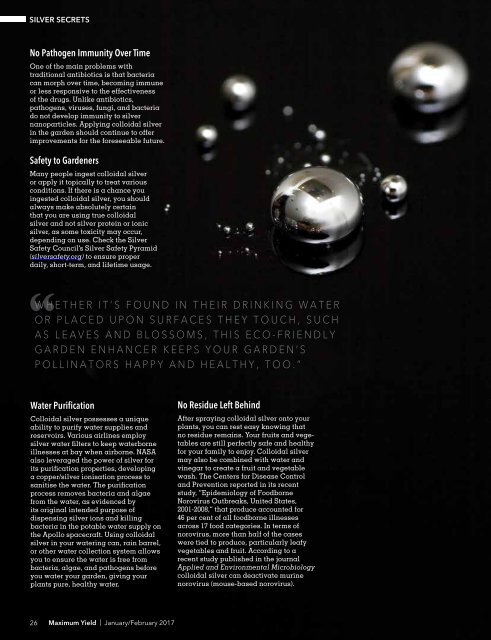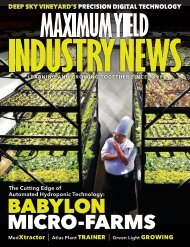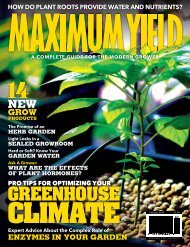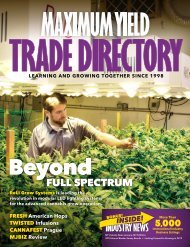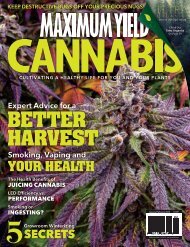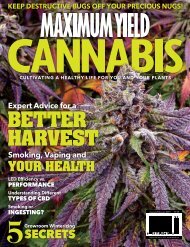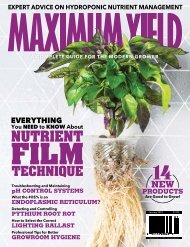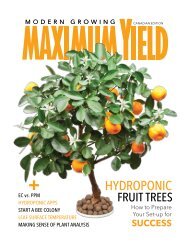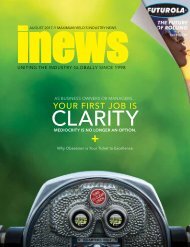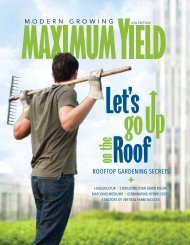Maximum Yield Modern Growing | UK/EU Edition | January/February 2017
The world of indoor growing is expanding at an incredible rate. No longer the alternative to traditional agriculture, hydroponics is being recognised as beneficial for many important reasons. Hydroponics yields require up to 50 per cent less land to grow the same amount of produce, and as the world’s arable lands are diminished from overfarming and climate change, hydroponics takes the pressure off the environment by leaving more land available for wildlife reserves, biospheres, and other protected areas. Drought-ridden areas like California will appreciate the fact hydroponics uses only 10 per cent of the water needed for growing in soil, and far less chemicals and fertilisers-as much as 60 per cent less- are required. By most reports, growing and transporting food around the globe accounts for as much as 30 per cent of all greenhouse gas emissions. With hydroponics, we can grow almost anything right where we live, reducing the need for carbon emissions. This is especially important for people who live in the Far North. More and more, programs are being created to provide fresh produce for those who live in northern communities, reducing the need to ship relatively small amounts of food while providing food security with fresh, inexpensive fruits and vegetables. It is with these shifts in mind that we’ve made some editorial changes in Maximum Yield. As you may have noticed, on our cover we’ve changed ‘indoor gardening’ to ‘modern growing’. As the industry evolves, so are we. Our content will include a wider look at the advancements in the growing world, both indoors and out. As we flip the calendar from 2016 to 2017, we are taking a new perspective on the world of modern growing, and we look forward to bringing these stories to you. We also wish you and your loved ones the very best for 2017. In the meantime, we hope you have as much fun reading this issue as we did putting it together. As always, thanks for reading Maximum Yield and if you have any questions feel free to contact us at editor@maximumyield.com.
The world of indoor growing is expanding at an incredible rate. No longer the alternative to traditional agriculture, hydroponics is being recognised as beneficial for many important reasons. Hydroponics yields require up to 50 per cent less land to grow the same amount of produce, and as the world’s arable lands are diminished from overfarming and climate change, hydroponics takes the pressure off the environment by leaving more land available for wildlife reserves, biospheres, and other protected areas. Drought-ridden areas like California will appreciate the fact hydroponics uses only 10 per cent of the water needed for growing in soil, and far less chemicals and fertilisers-as much as 60 per cent less- are required. By most reports, growing and transporting food around the globe accounts for as much as 30 per cent of all greenhouse gas emissions. With hydroponics, we can grow almost anything right where we live, reducing the need for carbon emissions. This is especially important for people who live in the Far North. More and more, programs are being created to provide fresh produce for those who live in northern communities, reducing the need to ship relatively small amounts of food while providing food security with fresh, inexpensive fruits and vegetables. It is with these shifts in mind that we’ve made some editorial changes in Maximum Yield. As you may have noticed, on our cover we’ve changed ‘indoor gardening’ to ‘modern growing’. As the industry evolves, so are we. Our content will include a wider look at the advancements in the growing world, both indoors and out. As we flip the calendar from 2016 to 2017, we are taking a new perspective on the world of modern growing, and we look forward to bringing these stories to you. We also wish you and your loved ones the very best for 2017. In the meantime, we hope you have as much fun reading this issue as we did putting it together. As always, thanks for reading Maximum Yield and if you have any questions feel free to contact us at editor@maximumyield.com.
Create successful ePaper yourself
Turn your PDF publications into a flip-book with our unique Google optimized e-Paper software.
SILVER SECRETS<br />
No Pathogen Immunity Over Time<br />
One of the main problems with<br />
traditional antibiotics is that bacteria<br />
can morph over time, becoming immune<br />
or less responsive to the effectiveness<br />
of the drugs. Unlike antibiotics,<br />
pathogens, viruses, fungi, and bacteria<br />
do not develop immunity to silver<br />
nanoparticles. Applying colloidal silver<br />
in the garden should continue to offer<br />
improvements for the foreseeable future.<br />
Safety to Gardeners<br />
Many people ingest colloidal silver<br />
or apply it topically to treat various<br />
conditions. If there is a chance you<br />
ingested colloidal silver, you should<br />
always make absolutely certain<br />
that you are using true colloidal<br />
silver and not silver protein or ionic<br />
silver, as some toxicity may occur,<br />
depending on use. Check the Silver<br />
Safety Council’s Silver Safety Pyramid<br />
(silversafety.org) to ensure proper<br />
daily, short-term, and lifetime usage.<br />
“WHETHER IT’S FOUND IN THEIR DRINKING WATER<br />
OR PLACED UPON SURFACES THEY TOUCH, SUCH<br />
AS LEAVES AND BLOSSOMS, THIS ECO-FRIENDLY<br />
GARDEN ENHANCER KEEPS YOUR GARDEN’S<br />
POLLINATORS HAPPY AND HEALTHY, TOO.”<br />
Water Purification<br />
Colloidal silver possesses a unique<br />
ability to purify water supplies and<br />
reservoirs. Various airlines employ<br />
silver water filters to keep waterborne<br />
illnesses at bay when airborne. NASA<br />
also leveraged the power of silver for<br />
its purification properties, developing<br />
a copper/silver ionisation process to<br />
sanitise the water. The purification<br />
process removes bacteria and algae<br />
from the water, as evidenced by<br />
its original intended purpose of<br />
dispensing silver ions and killing<br />
bacteria in the potable water supply on<br />
the Apollo spacecraft. Using colloidal<br />
silver in your watering can, rain barrel,<br />
or other water collection system allows<br />
you to ensure the water is free from<br />
bacteria, algae, and pathogens before<br />
you water your garden, giving your<br />
plants pure, healthy water.<br />
No Residue Left Behind<br />
After spraying colloidal silver onto your<br />
plants, you can rest easy knowing that<br />
no residue remains. Your fruits and vegetables<br />
are still perfectly safe and healthy<br />
for your family to enjoy. Colloidal silver<br />
may also be combined with water and<br />
vinegar to create a fruit and vegetable<br />
wash. The Centers for Disease Control<br />
and Prevention reported in its recent<br />
study, “Epidemiology of Foodborne<br />
Norovirus Outbreaks, United States,<br />
2001-2008,” that produce accounted for<br />
46 per cent of all foodborne illnesses<br />
across 17 food categories. In terms of<br />
norovirus, more than half of the cases<br />
were tied to produce, particularly leafy<br />
vegetables and fruit. According to a<br />
recent study published in the journal<br />
Applied and Environmental Microbiology<br />
colloidal silver can deactivate murine<br />
norovirus (mouse-based norovirus).<br />
26 <strong>Maximum</strong> <strong>Yield</strong> | <strong>January</strong>/<strong>February</strong> <strong>2017</strong>


